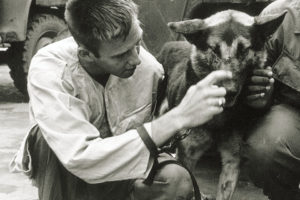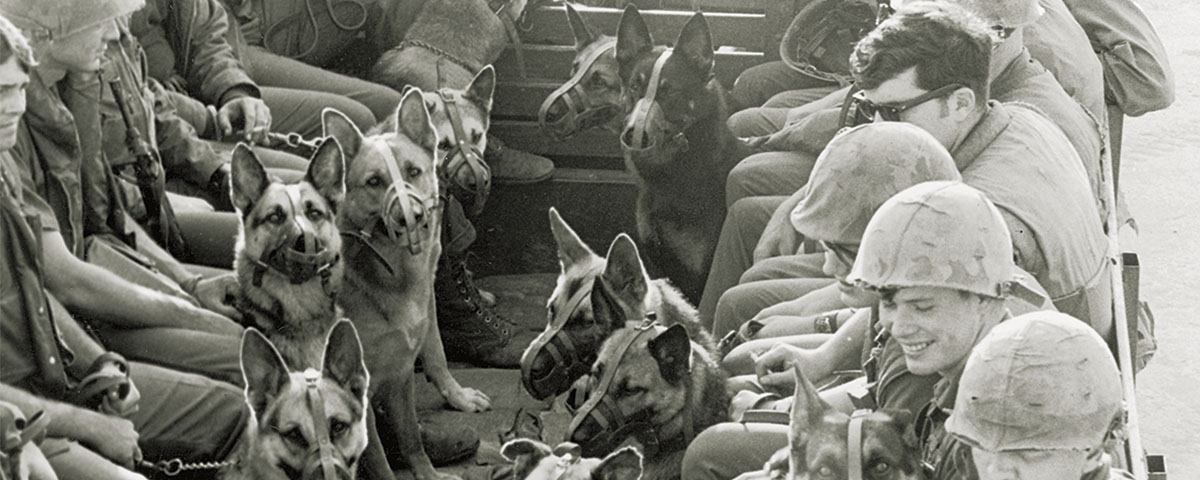On Dec. 4, 1966, Airman 2nd Class Bob Thorneburg and his German shepherd, Nemo, were walking patrol about a quarter of a mile from the runway at Tan Son Nhut Air Base, near Saigon. They had just started when Nemo went on alert. Enemy fire erupted. Thorneburg released Nemo, and they charged the enemy. Nemo was shot in the head, the bullet entering under the right eye and exiting through his mouth. Thorneburg killed one of the Viet Cong before being shot.

Despite the serious head wound, Nemo continued to fight, throwing himself at the attackers and giving the severely wounded Thorneburg time to radio for help. Nemo crawled to where Thorneburg was lying and covered the airman with his body to protect him. Both man and dog survived, but both needed emergency medical attention. Thorneburg was flown to Japan and then to the United States. Nemo, after intense surgery to repair his head wounds, was flown to the U.S. as a “war hero” and retired at the Defense Department Dog Center at Lackland Air Force Base in Texas.
Most military dogs who served in Vietnam weren’t so fortunate. The mantra “no man left behind” was not amended to include the dogs who fought alongside the men.
As an article on Vice.com, which included an interview with former Army dog handler Rick Claggett, stated: “There was one group of U.S. veterans who, despite serving bravely and saving countless lives, were either executed or abandoned by the military they served.” Those veterans were the military working dogs.
The U.S. military deployed an estimated 4,000 dogs to Vietnam and Thailand during the war. The exact number is unknown because the military didn’t start keeping records of dogs serving in Vietnam until 1968. About 3,700 are confirmed by a “brand number” (similar to a GI’s serial number) tattooed in the dog’s left ear.
Only 204 of the dogs sent to Vietnam made it back to the States, or were reassigned to peaceful areas of the Pacific, in the war years of 1964-75, according to the U.S. War Dog Association. About 350 were killed, says Richard Cunningham, a sentry dog handler during the war, in a piece for The New York Times. Hundreds of others died from diseases, heat stroke, accidents and other noncombat causes.
But that doesn’t explain the fate of thousands more dogs. Why aren’t they accounted for? Simply put, the military and Congress considered the dogs “equipment” and therefore expendable. Thus little effort was made to bring them home, where they could enjoy “civilian life.”
The United States had been using military working dogs since World War I. The dogs deployed in both world wars and Korea saved an untold number of lives, and many lost theirs in the process, just as they did in Vietnam. “They loved to work purely for the approval and praise of their handler and partner,” Cunningham recalled.
Dogs were invaluable in Vietnam because of their ability to sense threats, even in the thick jungle. Dogs have 225 million scent receptors in their noses, compared with 5 million in humans. They can detect movement quicker than humans and hear four times better. Canines on missions in Vietnam included scout dogs, tracker dogs, sentry dogs and dogs used to detect mines, booby traps and enemy tunnels.
Scout teams were made up of a German shepherd and handler “walking point,” at the front of a patrol, to detect enemy troops ready to spring an ambush, snipers, trip wires and booby traps. Those teams were so effective that the North Vietnamese and Viet Cong put bounties on the heads of both the handlers and their dogs.
Tracker teams comprised a Labrador retriever, the handler, a cover man, a visual tracker and a team leader. They would hunt down enemy troops after a battle, usually by following blood trails and body odor. Trackers also assisted searches for downed pilots and missing soldiers.
Sentry teams, one dog and a handler, “walked the wire”—barbed wire surrounding installations—to provide security for bases, ammo dumps and supply areas. Working mainly at night, their mission was to “detect, detain and destroy” enemy invaders before they got inside the wire.
Other teams of one dog and a handler were used to detect mines, booby traps and other devices that could produce U.S. casualties. Those dogs also discovered tunnels and sometime were sent down to flush out the enemy.
Even before the 1965 arrival of combat troops, the Air Force had started a research project in Saigon to explore the use of dogs in the tropics. In 1961 the Air Force sent two instructors and 10 dogs to assist in base security. The South Vietnamese weren’t interested, however, so the U.S. handlers went home, and the dogs were left with the Army of the Republic of Vietnam.
In July 1962, an additional 300 dogs sent by the U.S. Army arrived in South Vietnam and were turned over to the ARVN. But problems quickly arose. There were no veterinarians in the country, and ARVN troops didn’t feed the dogs properly because of the expense. “Nearly 90 percent of ARVN dog deaths could be attributed to malnutrition,” according to website K-9 History. To improve conditions for the dogs, the Army sent a six-man team to establish veterinary support.
In March 1965, President Lyndon B. Johnson officially authorized the use of U.S. military working dogs in Vietnam. In July the Air Force sent 40 handlers and dogs. In September, the Army landed its first dogs in South Vietnam. February 1966 saw two Marine dog platoons sent to Vietnam. By April 1966, the Navy also had dogs there.
In 1970, as American troops were being sent home as part of multiyear withdrawal, the U.S. government began to turn over many of its military dogs to the ARVN even though the South Vietnamese military didn’t want them and couldn’t handle them.
There are no records of what exactly happened to the dogs left in the ARVN’s care during the course of the war. However, dogs are considered a food item in Vietnam, and there is a good possibility some were killed and eaten.
Most of the other dogs remaining in Vietnam during the last years of the war were euthanized by the U.S. military or abandoned.
Many handlers saw their dogs differently than the government did. “They weren’t a piece of equipment to us,” Claggett said. “I loved that dog. It was a living, breathing thing that had emotions and played and did all kinds of dog things.” Some handlers tried to get permission to bring the dogs home, even at their own expense. The government’s answer was a flat-out “no.”
The handlers appealed to the American public and press. “We made some phone calls trying to convince people to help bring our dogs back home,” Claggett said. Under public pressure, the Defense Department in 1970 put 200 dogs in quarantine at the Long Binh base north of Saigon, in preparation for a return home. In September 1970, U.S. Rep. John E. Moss, a California Democrat, introduced legislation to create retraining or retirement shelters for canine veterans. His bill went nowhere. Before long, the military changed its mind about the dogs. Most were not going to be repatriated.
By May 1971 only 120 of the dogs in quarantine at Long Binh were still alive, but they were among the fortunate 204 survivors. They found homes in Okinawa, Japan; Fort Benning, Georgia; or Lackland Air Force Base. In June 1972 the 130 dogs then remaining under U.S. military control in South Vietnam were turned over to the ARVN.
Turning the dogs over to the ARVN or, in some cases, euthanizing them, was a “cost effective” way to deal with something regarded as just another piece of military gear being left behind. Bringing the dogs back from Vietnam would have been a huge logistical problem, but no one worried about cost or logistics when the dogs were sent there.
America’s canine “soldiers,” estimated by some to have saved 10,000 lives, were deserted by the people they served—a violation of the “leave no one behind” creed and a stain on our country. It is believed that all the “American” dogs turned over to the ARVN perished when the North Vietnamese overran South Vietnam, though there are no official records. One would like to think the dogs went down fighting just as they were trained to do; just as all American soldiers are trained to do.
Dana Benner teaches history, political science and sociology at the university level. He served more than 10 years in the U.S. Army.
Do you have reflections on the war that you would like to share? Email your idea or article to Vietnam@HistoryNet.com, subject line: Reflections.





